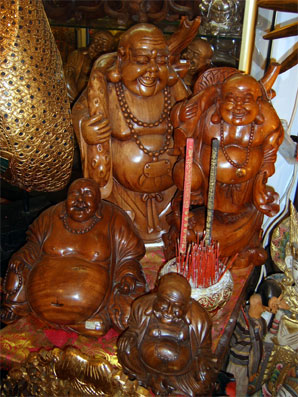  |
 
Different representations of the Chinese Mi Lo Fo out of fruit wood
 
From the history of the famous Mi Lo Fo:
According to transmission, this form of the monk Pu-tai, who lived in the 10th century in China,
is supposed to have wandered through the villages with a beggar’s sack made of hemp on his back.
Countless stories arose around Pu-tai, presenting him as an eccentric magician, whose actions
express the spirit of the rising Zen religion which at that time was coming into fashion. The remark
he made in his hour of death, revealed the tradition regarding his true identity as the incarnation
of the future Buddha Maitreya: “Maitreya, true Maitreya, countless times reborn, appearing
from time to time among humans, nevertheless, the people of the time do not recognize him.”
One finds Mi Lo Fo in every Chinese Closter and temple today. In his figure some Chinese
life ideals are depicted pictorially:
The fat belly symbolizes wealth; his laughter and relaxed sitting posture shows calm and satisfaction
with himself and the world. The children, that often surround him, illustrate his great love of children,
one of the main virtues of the Chinese people. |
|









